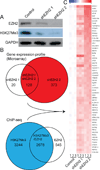ALDH1A1 is a novel EZH2 target gene in epithelial ovarian cancer identified by genome-wide approaches
- PMID: 22144423
- PMCID: PMC3294119
- DOI: 10.1158/1940-6207.CAPR-11-0414
ALDH1A1 is a novel EZH2 target gene in epithelial ovarian cancer identified by genome-wide approaches
Abstract
Epithelial ovarian cancer (EOC) remains the most lethal gynecologic malignancy in the United States. EZH2 silences gene expression through trimethylating lysine 27 on histone H3 (H3K27Me3). EZH2 is often overexpressed in EOC and has been suggested as a target for EOC intervention. However, EZH2 target genes in EOC remain poorly understood. Here, we mapped the genomic loci occupied by EZH2/H3K27Me3 using chromatin immunoprecipitation followed by next-generation sequencing (ChIP-seq) and globally profiled gene expression in EZH2-knockdown EOC cells. Cross-examination of gene expression and ChIP-seq revealed a list of 60 EZH2 direct target genes whose expression was upregulated more than 1.5-fold upon EZH2 knockdown. For three selected genes (ALDH1A1, SSTR1, and DACT3), we validated their upregulation upon EZH2 knockdown and confirmed the binding of EZH2/H3K27Me3 to their genomic loci. Furthermore, the presence of H3K27Me3 at the genomic loci of these EZH2 target genes was dependent upon EZH2. Interestingly, expression of ALDH1A1, a putative marker for EOC stem cells, was significantly downregulated in high-grade serous EOC (n = 53) compared with ovarian surface epithelial cells (n = 10, P < 0.001). Notably, expression of ALDH1A1 negatively correlated with expression of EZH2 (n = 63, Spearman r = -0.41, P < 0.001). Thus, we identified a list of 60 EZH2 target genes and established that ALDH1A1 is a novel EZH2 target gene in EOC cells. Our results suggest a role for EZH2 in regulating EOC stem cell equilibrium via regulation of ALDH1A1 expression.
Conflict of interest statement
Figures




Similar articles
-
Enhancer of zeste homolog 2 promotes the proliferation and invasion of epithelial ovarian cancer cells.Mol Cancer Res. 2010 Dec;8(12):1610-8. doi: 10.1158/1541-7786.MCR-10-0398. Epub 2010 Nov 29. Mol Cancer Res. 2010. PMID: 21115743 Free PMC article.
-
NF-YA underlies EZH2 upregulation and is essential for proliferation of human epithelial ovarian cancer cells.Mol Cancer Res. 2013 Apr;11(4):360-9. doi: 10.1158/1541-7786.MCR-12-0661. Epub 2013 Jan 29. Mol Cancer Res. 2013. PMID: 23360797 Free PMC article.
-
EZH2-induced H3K27me3 is associated with epigenetic repression of the ARHI tumor-suppressor gene in ovarian cancer.Cell Biochem Biophys. 2015 Jan;71(1):105-12. doi: 10.1007/s12013-014-0168-1. Cell Biochem Biophys. 2015. PMID: 25077680
-
Aberrations of EZH2 in cancer.Clin Cancer Res. 2011 May 1;17(9):2613-8. doi: 10.1158/1078-0432.CCR-10-2156. Epub 2011 Mar 2. Clin Cancer Res. 2011. PMID: 21367748 Review.
-
Network-Based Integration of GWAS and Gene Expression Identifies a HOX-Centric Network Associated with Serous Ovarian Cancer Risk.Cancer Epidemiol Biomarkers Prev. 2015 Oct;24(10):1574-84. doi: 10.1158/1055-9965.EPI-14-1270. Epub 2015 Jul 24. Cancer Epidemiol Biomarkers Prev. 2015. PMID: 26209509 Free PMC article. Review.
Cited by
-
CBX2 identified as driver of anoikis escape and dissemination in high grade serous ovarian cancer.Oncogenesis. 2018 Nov 26;7(11):92. doi: 10.1038/s41389-018-0103-1. Oncogenesis. 2018. PMID: 30478317 Free PMC article.
-
Stemness-Related Markers in Cancer.Cancer Transl Med. 2017;3(3):87-95. doi: 10.4103/ctm.ctm_69_16. Epub 2017 Jun 8. Cancer Transl Med. 2017. PMID: 29276782 Free PMC article.
-
Estrogen-related receptors alpha, beta and gamma expression and function is associated with transcriptional repressor EZH2 in breast carcinoma.BMC Cancer. 2018 Jun 26;18(1):690. doi: 10.1186/s12885-018-4586-0. BMC Cancer. 2018. PMID: 29940916 Free PMC article.
-
PRC2 regulates RNA polymerase III transcribed non-translated RNA gene transcription through EZH2 and SUZ12 interaction with TFIIIC complex.Nucleic Acids Res. 2015 Jul 27;43(13):6270-84. doi: 10.1093/nar/gkv574. Epub 2015 Jun 1. Nucleic Acids Res. 2015. PMID: 26038315 Free PMC article.
-
H3K27me3 is an Epigenetic Mark of Relevance in Endometriosis.Reprod Sci. 2015 Sep;22(9):1134-42. doi: 10.1177/1933719115578924. Epub 2015 Mar 27. Reprod Sci. 2015. PMID: 25820690 Free PMC article.
References
-
- Cao R, Wang L, Wang H, Xia L, Erdjument-Bromage H, Tempst P, et al. Role of histone H3 lysine 27 methylation in Polycomb-group silencing. Science. 2002;298:1039–1043. - PubMed
Publication types
MeSH terms
Substances
Grants and funding
LinkOut - more resources
Full Text Sources
Medical
Molecular Biology Databases
Miscellaneous

